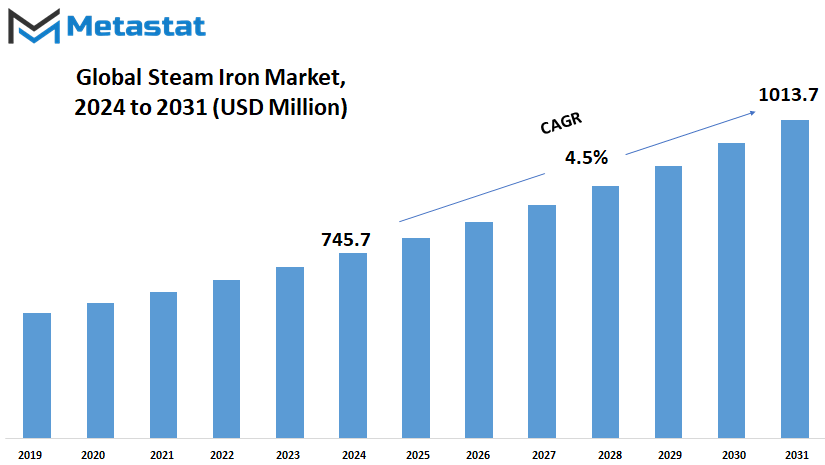MARKET OVERVIEW
The Global Steam Iron market, nestled within the broader appliance industry, is a dynamic landscape driven by innovation, consumer preferences, and technological advancements. As an essential household appliance, steam irons have transcended their conventional role of merely removing wrinkles from clothes. They represent a fusion of utility and technology, catering to the ever-changing needs of consumers across the globe.
In the forthcoming years, the Global Steam Iron market is poised to witness significant transformations, fueled by advancements in materials, design, and functionality. Manufacturers are anticipated to introduce steam irons equipped with smart features, integrating IoT capabilities to provide users with enhanced convenience and efficiency. These futuristic appliances will allow users to control and monitor ironing processes remotely through smartphone applications, ensuring a seamless and personalized experience.
Furthermore, sustainability is set to emerge as a key focus area within the Global Steam Iron market. With growing environmental consciousness among consumers, manufacturers are expected to prioritize eco-friendly materials and energy-efficient technologies in their product offerings. The adoption of renewable energy sources for steam generation and the use of recycled materials in manufacturing processes will contribute to reducing the environmental footprint of steam irons, aligning with global sustainability goals.
The future of the Global Steam Iron market also entails the convergence of fashion and technology. As fashion trends evolve, steam irons will evolve accordingly to cater to the specific needs of different fabrics and garment styles. Advanced steam control mechanisms and temperature settings will ensure precise and delicate ironing, preserving the integrity of even the most intricate fabrics.
Moreover, the advent of artificial intelligence (AI) and machine learning is expected to revolutionize the way steam irons operate. AI-powered steam irons will analyze fabric types and textures in real-time, automatically adjusting steam intensity and temperature to achieve optimal results without the risk of damage. This integration of AI technology will not only enhance user experience but also contribute to extending the lifespan of garments by minimizing wear and tear caused by incorrect ironing techniques.
In addition to technological innovations, the Global Steam Iron market is likely to witness a shift in consumer preferences towards multifunctional appliances. Manufacturers will innovate to incorporate additional features such as garment steaming, sanitization, and deodorization into steam irons, offering users versatile solutions for garment care.
The Global Steam Iron market is poised for a transformative journey characterized by technological advancements, sustainability initiatives, and evolving consumer preferences. As manufacturers continue to innovate and adapt to changing market dynamics, steam irons will evolve from conventional household appliances to indispensable companions in the realm of garment care, catering to the diverse needs of consumers worldwide.
Global Steam Iron market is estimated to reach $1013.7 Million by 2031; growing at a CAGR of 4.5% from 2024 to 2031.

GROWTH FACTORS
The global steam iron market is poised for significant growth in the coming years, driven by several key factors. One of the main drivers is the increasing demand for efficient and easy-to-use household appliances. As people's lives become busier, the need for quick and effective solutions for daily tasks like ironing becomes more important. Steam irons, known for their superior ability to remove wrinkles and creases from clothes, are becoming a household staple.
Additionally, technological advancements in steam iron design and functionality are fueling market growth. Modern steam irons are equipped with features such as auto shut-off, anti-drip technology, and variable steam settings, which make them more user-friendly and efficient. These innovations not only enhance the ironing experience but also appeal to tech-savvy consumers looking for high-performance appliances.
Another factor contributing to the growth of the steam iron market is the rise in disposable income among consumers, particularly in developing regions. As more people can afford to purchase household appliances, the demand for steam irons is expected to increase. Moreover, the expansion of e-commerce platforms has made it easier for consumers to access a wide variety of steam irons, further boosting market growth.
However, the market is not without its challenges. One potential obstacle is the increasing preference for wrinkle-free fabrics, which reduces the need for ironing. As manufacturers continue to develop fabrics that require little to no ironing, the demand for steam irons might see a decline. Additionally, the growing awareness of environmental issues and the push for energy-efficient appliances could impact the market, as consumers may opt for alternatives that consume less power.
Despite these challenges, there are still ample opportunities for growth in the steam iron market. For instance, the development of more energy-efficient steam irons can attract environmentally conscious consumers. Furthermore, innovations such as cordless steam irons and those with advanced temperature control systems can capture the interest of consumers looking for convenience and precision.
Looking to the future, the global steam iron market is expected to continue evolving, with manufacturers focusing on creating more sustainable and user-friendly products. As consumer preferences shift towards more advanced and eco-friendly appliances, the market will likely see the introduction of steam irons that not only meet but exceed these expectations. This trend presents lucrative opportunities for companies willing to invest in research and development to stay ahead of the curve.
The global steam iron market is on a promising growth trajectory, driven by technological advancements, increasing disposable income, and the convenience offered by modern steam irons. While challenges such as the rise of wrinkle-free fabrics and environmental concerns may pose threats, the development of energy-efficient and innovative products will provide significant opportunities for market expansion in the coming years.
MARKET SEGMENTATION
By Type
The future of the global Closed-System Transfer Devices market promises significant advancements and growth, particularly when examining the different types available. This market is primarily divided into corded and cordless iron devices. As we look forward, understanding the evolution and potential of these devices is crucial.
Corded iron devices have long been a staple in many industries. They offer a reliable and consistent performance, essential for environments where uninterrupted power is critical. These devices are often favored for their stability and the assurance that they will not run out of power during crucial tasks. As technology progresses, we can expect corded devices to become more efficient, with enhanced safety features and improved ease of use. Innovations in materials and design will likely make these devices lighter and more durable, increasing their appeal and functionality in various settings.
On the other hand, cordless iron devices represent a significant shift towards convenience and flexibility. The ability to operate without being tethered to a power source is a substantial advantage, allowing for greater mobility and ease of use in multiple scenarios. As battery technology continues to advance, cordless devices are expected to see improvements in battery life, charging speed, and overall performance. Future developments might also focus on creating more environmentally friendly batteries, aligning with global sustainability goals. The enhancement of wireless charging technology could further revolutionize the use of cordless devices, making them even more practical and efficient.
Both corded and cordless iron devices have their unique advantages and applications. The choice between the two often depends on the specific needs and preferences of the user. However, the trend seems to be moving towards cordless options due to the increasing demand for flexibility and convenience in various professional and personal environments. The ongoing research and development in this field are likely to bring forth innovative solutions that address the current limitations of both types, making them more versatile and user-friendly.

By Applications
The future of the Global Closed-System Transfer Devices market is marked by significant advancements and expanding applications. These devices, designed to prevent contamination and ensure safe handling of hazardous drugs, are becoming increasingly essential. By examining their applications in residential and commercial settings, we can better understand their potential impact and growth trajectory.
In residential environments, closed-system transfer devices (CSTDs) are set to revolutionize home healthcare. As more patients opt for home treatments for chronic conditions, the demand for safe and efficient drug handling solutions rises. CSTDs will ensure that patients and caregivers can manage medications without exposure to harmful substances. This not only improves the safety and quality of home healthcare but also makes it more accessible and convenient for patients. The focus on safety and ease of use will drive innovation, leading to more user-friendly and affordable devices that can be seamlessly integrated into everyday home care routines.
Commercial applications of CSTDs are equally promising. In hospitals and clinics, these devices are vital for protecting healthcare workers from exposure to hazardous drugs during preparation and administration. The future will likely see CSTDs becoming a standard requirement in medical settings worldwide, driven by stricter regulations and a growing emphasis on occupational safety. Beyond healthcare facilities, industries such as pharmaceuticals and biotechnology will also increasingly rely on CSTDs. These sectors require stringent contamination control to maintain product integrity and safety, making CSTDs an indispensable tool.
By Distribution Channel
The Global Closed-System Transfer Devices (CSTD) market is expanding rapidly, driven by the increasing need for safer and more efficient ways to handle hazardous drugs. By distribution channel, the market is further divided into offline and online segments, each with its unique advantages and potential for growth.
The offline distribution channel traditionally includes physical stores, pharmacies, and direct sales from manufacturers. This channel has been the backbone of the CSTD market for many years, providing customers with the opportunity to interact directly with suppliers and see the products firsthand. This personal interaction often builds trust and ensures that customers can ask questions and receive immediate feedback. However, the offline market faces challenges, such as limited geographic reach and higher operational costs due to the need for physical space and inventory management.
On the other hand, the online distribution channel has seen remarkable growth and is poised to dominate the future of the CSTD market. Online platforms offer unparalleled convenience, allowing customers to browse and purchase products from the comfort of their homes or offices. The ease of comparing prices and reading reviews has empowered customers to make more informed decisions. Furthermore, the lower overhead costs associated with online sales enable businesses to offer competitive pricing and special deals, attracting a wider audience.
By Price Point
The future of the global Closed-System Transfer Devices (CSTD) market promises to be transformative, marked by advancements that will significantly impact both healthcare and safety protocols. CSTDs are essential tools in preventing hazardous drug exposure, protecting healthcare workers, and ensuring the safe handling of medications. As awareness of occupational hazards increases and regulatory standards become more stringent, the demand for CSTDs is expected to grow steadily.
In the coming years, innovations in CSTD technology will likely focus on enhancing efficiency and user-friendliness. Manufacturers are anticipated to invest heavily in research and development to create devices that are not only safer but also more intuitive for healthcare professionals to use. This could include the integration of smart technology, allowing for real-time monitoring and data collection, which can help track exposure levels and improve safety protocols.
The market will be segmented by price points, offering both mass and premium options to cater to diverse customer needs. The mass segment will likely see growth due to the rising need for cost-effective solutions in emerging economies. These regions are becoming more aware of the importance of workplace safety and are seeking affordable yet reliable CSTD options. On the other hand, the premium segment will continue to thrive in developed countries where there is a higher budget for healthcare spending and a strong emphasis on top-notch safety standards.
In the broader context, the future of the CSTD market will be influenced by the overall healthcare industry's move towards sustainability and environmental responsibility. There will be a push towards developing CSTDs that not only protect human health but also minimize environmental impact. This might involve using eco-friendly materials and designing products that are easier to recycle or dispose of safely.
Furthermore, global collaboration and standardization will play a critical role. International bodies and health organizations will work together to create unified guidelines and standards for CSTDs, ensuring that safety measures are consistent worldwide. This will help in streamlining the production processes and ensuring that devices meet high-quality benchmarks irrespective of where they are manufactured.
REGIONAL ANALYSIS
The global Steam Iron market is segmented by geography into several key regions: North America, Europe, Asia-Pacific, South America, and the Middle East & Africa. Each of these regions has unique characteristics and market dynamics that influence the adoption and growth of steam iron products.
North America, comprising the U.S., Canada, and Mexico, is a significant market for steam irons. The high standard of living and widespread use of home appliances in this region drive demand. Consumers in North America often seek advanced features and high-quality products, leading manufacturers to innovate continuously. As technology advances, we can expect to see more energy-efficient and smart steam irons tailored to the tech-savvy North American consumer.
In Europe, countries such as the UK, Germany, France, and Italy are key players. The European market is characterized by its emphasis on sustainability and energy efficiency. With strict regulations and a strong focus on reducing carbon footprints, European consumers tend to favor eco-friendly steam irons. Future developments in this region will likely include increased integration of green technologies and smart home compatibility, catering to the environmentally conscious European market.
Asia-Pacific, including India, China, Japan, South Korea, and the Rest of Asia-Pacific, represents a rapidly growing market for steam irons. The rising middle class and increasing disposable incomes in countries like China and India are driving the demand for household appliances. Additionally, urbanization and changing lifestyles are contributing to this growth. In the future, we can expect manufacturers to focus on affordability and functionality, meeting the diverse needs of consumers in this dynamic region.
The South American market, encompassing Brazil, Argentina, and the Rest of South America, is also experiencing growth. Economic development and improving living standards are key factors contributing to the increased demand for steam irons. As the region continues to develop, there will likely be a greater focus on offering reliable and cost-effective products to appeal to a broad consumer base.
The Middle East & Africa region, divided into GCC Countries, Egypt, South Africa, and the Rest of Middle East & Africa, presents a unique set of opportunities and challenges. While some parts of this region have significant purchasing power and demand for high-end appliances, others may prioritize affordability and durability. The future of the steam iron market here will likely see a blend of luxury and practical products to cater to the diverse consumer needs across the region.
Overall, the global Steam Iron market is influenced by regional preferences and economic conditions. As technology evolves and consumer expectations shift, manufacturers will need to adapt and innovate to meet the specific demands of each region. The future holds promising advancements in energy efficiency, smart technology, and eco-friendly designs, making steam irons more efficient and user-friendly worldwide.
COMPETITIVE PLAYERS
The global market for Closed-System Transfer Devices (CSTD) is analyzed based on regional divisions, including North America, Europe, Asia-Pacific, South America, and Middle East & Africa. North America is further broken down into the United States, Canada, and Mexico. Europe comprises the United Kingdom, Germany, France, Italy, and the rest of Europe. Meanwhile, Asia-Pacific encompasses India, China, Japan, South Korea, and the rest of Asia-Pacific. South America includes Brazil, Argentina, and the rest of South America. Lastly, the Middle East & Africa region is divided into GCC Countries, Egypt, South Africa, and the rest of Middle East & Africa.
The division of the global Closed-System Transfer Devices market into these regions provides insights into the varying dynamics and factors influencing market growth across different geographical areas. Each region presents unique opportunities and challenges for market players, influenced by factors such as regulatory frameworks, healthcare infrastructure, economic conditions, and technological advancements.
North America, comprising the United States, Canada, and Mexico, is expected to witness significant growth in the CSTD market due to factors such as increasing healthcare expenditure, rising adoption of advanced medical technologies, and the presence of key market players. Europe, with countries like the United Kingdom, Germany, and France at the forefront, is also projected to experience substantial growth driven by initiatives aimed at enhancing healthcare facilities and increasing awareness about safety measures in medication handling.
In the Asia-Pacific region, countries like India, China, and Japan are anticipated to emerge as lucrative markets for Closed-System Transfer Devices, supported by rapid urbanization, expanding healthcare infrastructure, and growing investments in healthcare innovation. Similarly, South America, led by Brazil and Argentina, is poised for growth fueled by improving healthcare access and rising demand for safer medication handling practices.
The Middle East & Africa region, encompassing GCC Countries, Egypt, and South Africa, presents opportunities for market expansion due to increasing healthcare investments and a growing focus on enhancing healthcare quality and patient safety.
Overall, the regional analysis of the global Closed-System Transfer Devices market highlights the diverse landscape of opportunities and challenges across different parts of the world, shaping the strategies of market players and influencing the trajectory of market growth in the coming years.
Steam Iron Market Key Segments:
By Types
- Corded Iron
- Cordless Iron
By Applications
- Residential
- Commercial
By Distribution Channel
- Offline
- Online
By Price Point
- Mass
- Premium
Key Global Steam Iron Industry Players
- Laurastar
- Black and Decker Corporation
- Hoover
- Newell Brands (Breville)
- Conair LLC
- Electrolux Group
- Haier Group
- Hamilton Beach Brands, Inc.
- Sunbeam Products, Inc.
- Tefal
- Transform SR Brands LLC (Kenmore)
- Maytag
- Morphy Richards
- Kenwood
- Panasonic Corporation
WHAT REPORT PROVIDES
- Full in-depth analysis of the parent Industry
- Important changes in market and its dynamics
- Segmentation details of the market
- Former, on-going, and projected market analysis in terms of volume and value
- Assessment of niche industry developments
- Market share analysis
- Key strategies of major players
- Emerging segments and regional growth potential








 US: +1 3023308252
US: +1 3023308252






